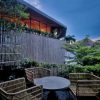The Keflavik Airport Development Company (Kadeco) today announced the winner of an international masterplanning competition for the Keflavik Airport Area. A multidisciplinary team led by KCAP was selected in a highly competitive process to develop a strategic masterplan for the area surrounding Keflavik, Iceland’s global aviation hub.
Kadeco’s CEO Pálmi Freyr Randversson praised the outcome of the competition as “a crucial step to realizing our future vision for the airport area.â€
According to Randversson, “the strategic masterplan will be a platform for innovation and value creation in key industries that drive the entire Icelandic economy: including aviation, logistics, seafood, and tourism. By drawing attention to Keflavik’s competitive advantages, the masterplan aims to attract new investment and create new job opportunities in the airport area.â€
Randversson highlighted the dynamic context in which the masterplan is being created. “The population here on the Reykjanes peninsula is growing very quickly. It’s one of the fastest growing regions in Iceland, and even in Europe. The masterplan provides a framework for the airport area’s sustainable, long-term development. We’ll also use it to launch near-term projects in the next 5-10 years.â€
“These are ambitious goals—and we can’t achieve them on our own,†Randversson said. “That’s why I’m thrilled to partner with Team KCAP on this project of national importance.â€
Founded in 2006, Kadeco leads the planning and development of a 55km2 area surrounding Keflavik International Airport (KEF). Kadeco is supervised by Iceland’s finance ministry and national aviation authority, and by two local municipalities on the Reykjanes peninsula. These four partners have joined forces to strengthen the airport area’s global competitiveness and enhance its attractiveness as a place to live, work, and visit.
Randversson noted that KCAP’s winning proposal “showed a nuanced understanding of the of sustainable urban development in the context of a major international airport.†He praised Team KCAP’s persuasive approach to adapting leading-edge global design practices to Iceland’s unique physical environment and Icelandic values, which emphasize an openness to new ideas and a hands-on attitude to implementation. “We’re a small society, but we punch far above our weight when it comes to climate change and new technologies. We also place a lot of importance on inclusiveness and collaboration.â€
An 18-member evaluation team, made up of both local residents and global subject matter experts, scored the competition entries. Evaluators praised KCAP’s emphasis on compact development, intensification of existing resources, and sustainable mobility solutions. They also lauded KCAP’s pragmatic phasing strategy and innovative approach to economic diversification.
The winning proposal seeks to capitalize on Keflavik’s strategic position between Europe and North America, its plentiful supply of renewable energy, and the captivating landscape of the Reykjanes UNESCO Geopark. At the same time, the masterplan emphasizes a people-focused approach, called airport urbanism, to ensure that the airport and local communities grow together in a mutually beneficial manner.
KCAP partner Anouk Kuitenbrouwer concurs. “The success of the masterplan will depend on collaboration between the public and private stakeholders,†she said. “At the same time, a project of such significance requires a design approach that is both bold yet sensitive. Strategically located complementary areas can be developed step-by-step, while the open landscape of the Airport Corridorwill be safeguarded through innovative landscape measures. We look forward to a lasting partnership with Kadeco. Our entire team is extremely excited to take on this challenge!â€
The winning proposal identifies three catalyst sites that will strengthen existing industries and promote development in new areas such as green hydrogen, electric aviation, and marine aquaculture. The catalyst sites are connected by a multimodal Airport Corridor that will significantly improve ground connections between the airport and the Reykjavik capital area. The Airport Corridor also forms the centerpiece of Team KCAP’s ambitious landscape strategy, which proposes reforestation as both a climate mitigation tool and as a clever placemaking technique.
KCAP placed first among the competition’s five finalists, ahead of Arup, Jacobs, OMA, and Aecom. Kadeco’s procurement team was supported by Alta, Bird & Bird, Ricondo& Associates, and Dr. Max Hirsh.
Design Team
KCAP, Zurich (urban planning and urban design)
WSP, London (economic and real estate development, collaborative development and organizational readiness)
Felixx Landscape Architects & Planners, Rotterdam (landscape architect)
MIC Mobility in Chain, Milan (mobility and transport planning)
VSO Consulting, ReykjavÃk (local coordination, urban planning)
Buck Consultants International, Nijmegen/The Hague (cargo planning)
Buro Happold, Berlin (climate and aviation mitigation, environmental performance and energy supply strategy)
Base Design, Brussels (placemaking and wayfinding)
MauritsSchaafsma, Amsterdam (airport area masterplanning)
AmbergLoglay, Zurich (emerging aviation technologies)
KanonArkitektar, ReykjavÃk (local architect and landscape architect)
ClientKadeco (KeflavÃk Airport Development Company), KeflavÃk
Program Strategic Masterplan for the development of the KeflavÃk Airport Area








